Exploring the Role of Rugs in Modern Home Decor
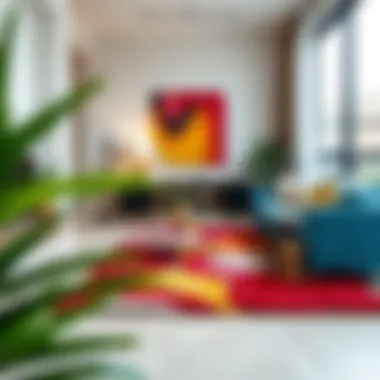
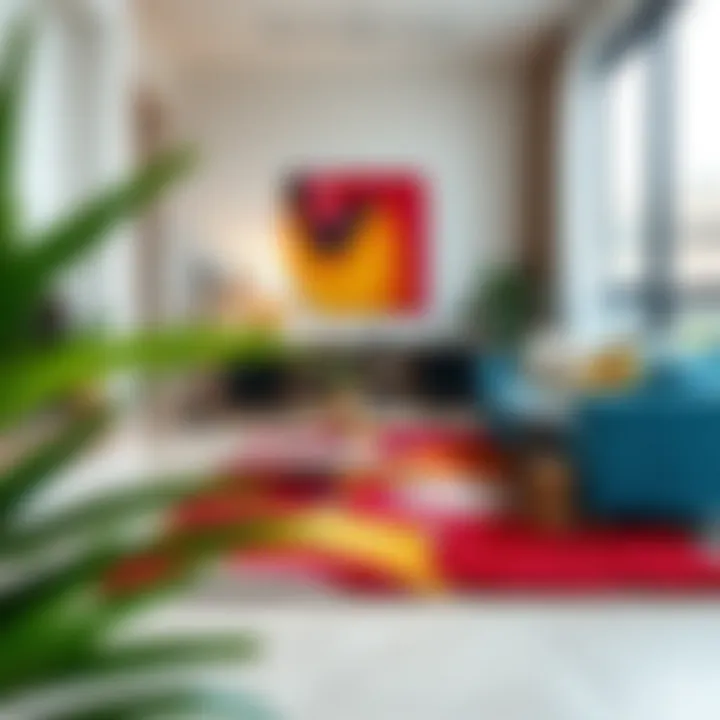
Intro
When one thinks about home decor, rugs may not always be the first item that pops to mind. Yet, these decorative textiles hold a power that goes beyond mere aesthetics. Rugs can redefine spaces, anchor furniture, and add warmth underfoot. In the world of modern interiors, their versatility shines through. From the simple cotton mat rolling out underfoot in a cozy living room to an intricate Persian rug gracing the entryway, there's a whole lot to unpack.
In this article, we explore how rugs breathe life into contemporary spaces. We’ll discuss various types of rugs, delve into their design elements, and consider their functionality. Every rug tells a story—one crafted through textures, colors, and patterns. So, whether you're an interior designer looking to make a statement or a homeowner seeking to beautify your space, this guide will provide insights to navigate the vast world of rugs with confidence.
Furniture Design Trends
Current Trends in Furniture Design
In recent years, the trend in furniture design leans towards minimalism, sustainability, and multi-functionality. Homes are becoming smaller, and the need for space-efficient solutions is crucial. As a result, furniture that serves more than one purpose is gaining popularity.
Rugs play a unique role in this shift. They define areas within open floor plans, providing a visual separation that doesn’t require walls. Think of how a soft, plush area rug can transform a stark dining area into an inviting nook, or how a bold, graphic rug can turn a mundane workspace into a creative haven. Here are some notable trends:
- Natural Materials: Furniture crafted from sustainable, organic materials complements rugs woven from natural fibers.
- Layering: Mixing various rug styles and textures can create depth, making a space feel richer and more lived-in.
- Colors and Patterns: Daring color palettes and geometric patterns draw attention, while more subdued tones can ground a space.
Influential Designers to Follow
Many designers have shown how rugs can best fit into modern furniture design. Standout figures include:
- Kelly Wearstler: Renowned for her bold and eclectic style, she utilizes unique rugs to bring a room together.
- Marie Flanigan: Her designs emphasize the seamless integration of space and texture, often spotlighting rugs as focal points.
- Jonathan Adler: Known for his playful take on chic designs, Adler’s use of bright colors and whimsical patterns invigorates any interior.
"Design is not just what it looks like and feels like. Design is how it works." – Steve Jobs
Practical Tips for Rug Selection
Choosing the Right Materials
When selecting a rug, materials matter. They determine not just the look and feel, but also the durability. Here’s a brief look at popular options:
- Wool: Known for its resilience and warmth, ideal for high-traffic areas.
- Synthetic Fibers: Options like polypropylene are budget-friendly and stain-resistant, making them suitable for families.
- Natural Fibers: Jute and sisal offer a rustic look, perfect for adding texture but can be more delicate.
Maximizing Space with Smart Choices
The right rug can visually expand a small room or provide a cozy anchor in a large one. Here are some tips:
- Size Matters: For a cohesive look, choose a rug that accommodates the legs of your furniture. Typically, at least the front legs should lie on the rug.
- Shape Coordination: Match the shape of the rug with the furniture layout—round rugs can soften angular furniture arrangements.
- Color Coordination: Select a rug that harmonizes with your color palette or serves as a striking contrast to create an eye-catching focal point.
As we transition into the next sections of this article, the significance of choosing the right rug transcends decor; it’s about creating a space that feels like home, reflecting your personality while serving practical purposes. Stay tuned for a deeper dive into the various types of rugs and maintenance tips that ensure their longevity.
The Integral Role of Rugs in Interior Design
Rugs are much more than just decorative pieces scattered on the floor. In contemporary interiors, they embody a crucial role that intertwines functionality with aesthetics. When thoughtfully selected, a rug can unify a room, enhance the ambiance, and even delineate spaces in open-concept designs. Their presence helps to anchor furniture arrangements, establishing a defined area that invites conversation or relaxation. However, the significance of rugs extends well beyond mere aesthetics.
Understanding Rug Functionality
Rugs serve multiple purposes, contributing both practically and visually to interior spaces. They act as a protective layer over flooring, shielding wood or tiles from scratches and wear. Additionally, rugs provide comfort underfoot, making spaces feel warmer and more inviting, particularly in larger areas or homes with cold flooring materials.
Moreover, the right rug can even assist in controlling temperatures by insulating against drafts or cold surfaces. Depending on the material and thickness, rugs can also help with airflow, maintaining a cozy environment.
Aesthetic Enhancements
Visually, rugs hold the power to transform a bland room into a captivating space. They introduce color, texture, and pattern, serving as focal points that draw the eye. A vibrant, patterned rug can become the heart of the room, encouraging a playful interaction with surrounding elements.
In addition, the style of a rug can complement or contrast with existing decor. For instance, a vintage Persian rug effortlessly adds character to a modern setting, creating a dialogue between old and new.
- Rugs can also adjust the mood of a room; darker tones often lend sophistication, while lighter shades can make spaces feel airy and open.
- Different textures—from the rugged feel of natural fibers to the smooth touch of silk—also elevate the sensory experience of a home.
Rugs as Sound Insulators
Surprising as it may seem, rugs play an essential role in acoustic management. In spaces with bare floors, audio can bounce off surfaces, creating echoes and amplifying noise. However, introducing rugs can significantly dampen sound, making environments more tranquil. This is particularly important in homes with high ceilings or large open areas where noise tends to carry.
Depending on the density and thickness of the rug, it can absorb sound effectively and reduce ambient noise, leading to a more peaceful atmosphere. This quality contributes to creating an inviting environment for gatherings or relaxed moments at home.
"A well-chosen rug enhances the architecture of a room, echoing the personality of the inhabitants."
In sum, rugs are indispensable elements in modern interiors, intertwining functionality with style while catering to the practical needs of sound and comfort. Whether you are elevating the aesthetic appeal or improving acoustics, the right rug can make a world of difference.
Five Rug Types: A Comprehensive Overview
When considering the impact of rugs in modern interiors, understanding the variety of rug types available is crucial. Each rug type brings its own unique character, style, and functionality to a space, enabling homeowners and designers alike to make informed choices that enhance their living environments. This overview serves as a guide to the different kinds of rugs available today, highlighting their benefits, features, and suitability for various settings.
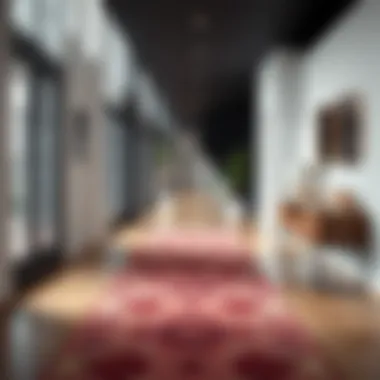
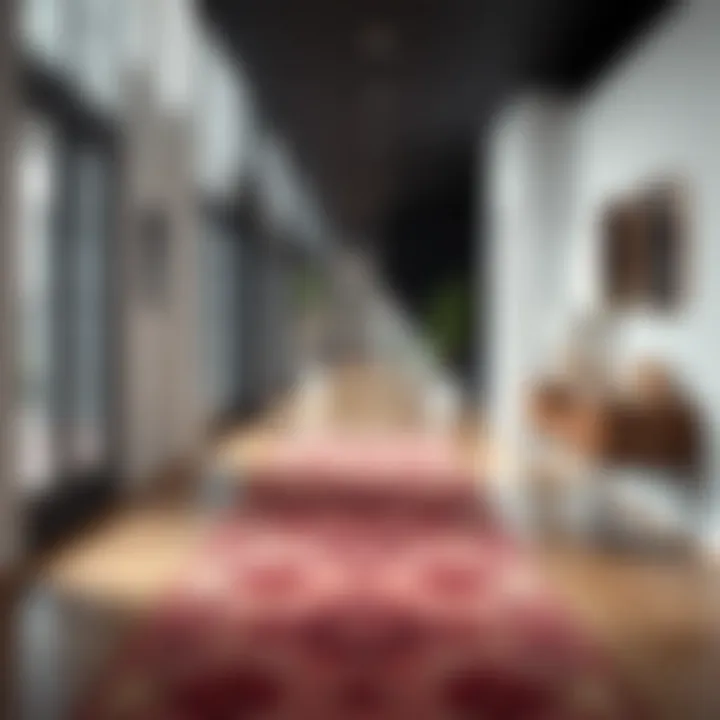
By exploring these five distinct rug types, the article aims to inform readers about how these elements can contribute to overall aesthetic appeal while serving practical purposes.
Traditional Persian Rugs
History and Craftsmanship
Traditional Persian rugs have a rich history dating back centuries, renowned for their intricate designs and superior craftsmanship. These rugs originate from Persia, present-day Iran, and they often depict historical or cultural motifs that tell stories through their patterns. A standout characteristic of Persian rugs is their hand-weaving technique which involves meticulous attention to detail, resulting in unique masterpieces that can take years to complete.
The history and craftsmanship not only make these rugs visually striking but also a worthwhile investment. While they can be on the pricier side, the longevity and quality they offer are often seen as advantageous. Their unique feature of being highly valued antiques often increases their worth over time, albeit requiring careful preservation to maintain their condition. This history adds layers of significance to the rug, making it a cherished centerpiece in any room.
Material and Design Characteristics
Persian rugs are typically woven with high-quality materials such as wool and silk. The durability and luster of these materials contribute significantly to the overall appeal. Patterns often include floral designs, medallions, and intricate borders, which draw the eye and enhance the room's decor. This makes Persian rugs a popular choice for those looking to add historical richness and elegance to their interiors.
One unique feature of these rugs is their ability to blend well with various design styles, from traditional to contemporary. However, they can be sensitive to light and damp conditions, requiring specific care and maintenance to prevent damage.
Contemporary Geometric Rugs
Trends in Design
Geometric rugs represent a modern twist on traditional designs, embracing clean lines and abstract shapes. The trend has gained traction in recent years, as more homeowners seek to incorporate minimalistic and modern aesthetics into their interiors. A defining characteristic of geometric rugs is their versatility, making them suitable for casual and sophisticated settings alike.
These rugs often serve as statement pieces that can anchor a room’s design. The rise in popularity of geometric patterns allows homeowners to inject personality into their spaces without overwhelming millwork or furnishings. However, their straightforward designs may not appeal to those who prefer intricate detailing found in traditional styles.
Color Palettes and Patterns
One of the key aspects of contemporary geometric rugs is the variety in color palettes. From bold hues to subtle neutrals, these rugs can complement or contrast with existing decor, offering style flexibility. The patterns can range from sharp triangles to circular designs, allowing for creative expression that enhances a room's overall flow.
While the vibrant colors can uplift a space, the unique designs may limit choices for furniture arrangements, especially in smaller spaces. This can become a deciding factor in a homeowner's selection process.
Natural Fiber Rugs
Sustainability Aspects
With a growing emphasis on sustainability, natural fiber rugs have found a niche in eco-conscious homes. Made from materials such as jute, sisal, and cotton, these rugs offer an eco-friendly alternative to synthetic options. The sustainable nature of these materials resonates with individuals looking to reduce their carbon footprint.
Natural fiber rugs are not only beneficial to the environment but also bring a touch of organic texture to any room. These rugs are often biodegradable and can be a cost-effective choice in the long run. However, their materials can sometimes lack the softness that synthetic fibers offer, making them less suitable for spaces designed for relaxation and comfort.
Texture and Comfort
The texture of natural fiber rugs is often coarse, providing a rustic charm that enhances a space's aesthetics. While they lend a more earthy aura, the comfort level can vary significantly. The unique feature here is their durability; these rugs can withstand heavy foot traffic, which makes them an excellent choice for busy areas. On the downside, they may not always provide the plush comfort desired in lounging or bedroom areas.
Shag Rugs
Feel and Aesthetic Value
Shag rugs are known for their luxurious feel and striking appearance. With deep piles made from various fibers, they offer a cozy and inviting texture underfoot. This tactile quality adds to their aesthetic value, making them a popular choice for living rooms and bedrooms where relaxation is key.
The shag's characteristic fluffiness creates a warm and inviting atmosphere, enhancing the overall appeal of a space. However, this plushness can also be a double-edged sword; while they look inviting, they can be challenging to clean and maintain. Dust and debris tend to settle deep within their fibers, necessitating regular upkeep to keep them looking fresh.
Placement Considerations
When placing a shag rug, understanding its surrounding context is vital. Their softness can create a contrast against hard floors or furniture, providing a visual anchor in open-plan spaces. However, they might not be the best fit for areas that see a lot of dirt or footfall, such as entryways. The unique placement aspect here revolves around their ability to define a cozy space but necessitating careful thought to ensure practicality is not sacrificed for beauty.
Outdoor Rugs
Materials Suitable for Outdoor Use
Outdoor rugs are specifically designed to withstand the elements. Manufactured from synthetic materials like polypropylene or polyester, they are resistant to moisture, fading, and general wear and tear. This durability is a significant aspect for homeowners looking to enhance their outdoor spaces without worrying about degradation from sun or rain.
These rugs can add style to patios, decks, or other outdoor settings, allowing for seasonal style changes seamlessly. However, they can lack the same level of softness and aesthetic warmth that indoor rugs offer, which might deter some from fully embracing their outdoor potential.
Durability and Maintenance
The durability of outdoor rugs makes them appealing for both casual and formal outdoor settings. They require minimal maintenance, often just a shake or hose down, keeping upkeep simple. Additionally, their ability to dry quickly prevents mold and mildew, making them practical for areas subjected to varying weather conditions.
On the downside, they may not maintain the same level of visual engagement as indoor options and can feel less inviting underfoot. Being informed about these trade-offs ensures the right choices are made based on the intended purpose of the space.
In summary, understanding the nuances of the five rug types enriches the conversation around modern interiors, blending practicality with elegance. Rug selection is more than mere decoration; it is about crafting an ambiance that reflects personal style, functionality, and the essence of a space.
Choosing the Right Rug for Your Space
Selecting the perfect rug for your home is not something to be taken lightly. A rug is more than just a decorative touch; it can drastically alter the ambiance of a room. The right choice can bring warmth, comfort, and functionality to your space while enhancing your decor. Poor choices, on the other hand, can clash with your overall aesthetic or quickly wear out due to inappropriate placement. Thus, understanding the importance of choosing the right rug is crucial in achieving a cohesive and inviting environment in modern interiors.
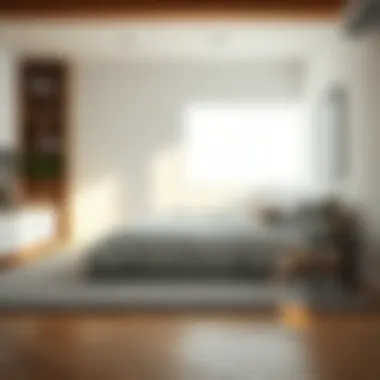

Assessing Room Functionality
High-Traffic Areas
When thinking about rugs for high-traffic areas, durability becomes your best friend. These spaces – think hallways, living rooms, or kitchens – experience a lot of foot traffic which necessitates a choice that can withstand daily wear and tear. Selecting a rug made of resilient materials, like synthetic fibers or tightly-woven natural fibers, ensures that it holds up against the hustle and bustle.
One strong point for high-traffic rugs is their potential for ease of cleaning. Usually, they can be tossed in the wash or easily vacuumed without much worry about damage. This quality makes them a popular pick among families and busy households. However, while durability is essential, don't compromise on style. Many contemporary designs offer beautiful aesthetics along with strength, so you can still have a fashionable space even in the busiest spots.
Relaxation Zones
In contrast, relaxation zones – such as bedrooms or quiet reading corners – call for rugs that focus on comfort. Here, softness becomes the priority. A plush shag rug or a deep-pile option can provide the comfort you need underfoot as you unwind after a long day. Such rugs often incorporate sumptuous textures that create an inviting atmosphere, making them ideal for spaces meant for repose.
A unique feature of relaxation zone rugs is their ability to contribute to a warmer, cozy environment. The right choice can turn a stark, cold space into a warm embrace. However, caution is needed; plush rugs are often harder to maintain and may not hold up well in damp areas. This trade-off is essential when considering both comfort and practicality.
Size and Placement Considerations
Room Dimensions
Room dimensions play a central role in the rug selection process. A rug that is too small can make a room feel disjointed, while one that is excessively large can engulf the space. Understanding the proportion between the rug and the room's size helps to create a balanced look. In open floor plans, oversized rugs can help delineate different areas, providing a visual anchor.
For instance, in a spacious living room, a larger area rug might serve as the foundation for furniture arrangement, pulling everything together harmoniously. This characteristic not only enhances the aesthetic appeal but also showcases the overall layout of the room. Choosing the right size keeps the flow of the room intact and can make a significant difference in how the space is perceived.
Furniture Arrangement
How a rug interacts with furniture arrangement is equally vital. A well-placed rug can tie together separate furniture pieces, creating an inviting and cohesive environment. When placing a rug under furniture, ensure there's enough of it to support the legs of the significant pieces. The ideal scenario is for the front legs of sofas and chairs to rest on the rug, creating a unified look.
On the flip side, leaving a rug floating without any furniture on it can often lead to a fragmented feel. Furthermore, the choice of design can either complement or clash with existing furniture. Thus, understanding how to layout a room in relation to the rug can elevate the entire space. It’s all about creating that seamless flow, making the choice of rug an essential aspect in furniture arrangement.
Maintenance and Care for Rugs
The longevity and beauty of rugs can greatly depend on how well they are maintained. This section emphasizes the importance of proper care for rugs, which can continue to enrich living spaces while avoiding premature wear. Not only does regular maintenance preserve the aesthetic quality, but it also offers practical benefits like improving indoor air quality and preventing dirt accumulation. Over time, neglecting these aspects can lead to costly replacements or extensive cleaning efforts.
Cleaning Techniques
Vacuuming Guidelines
In the realm of rug care, vacuuming stands out as a fundamental practice. It is essential for removing dirt and dust particles that can accumulate and degrade the rug fibers. Regular vacuuming helps to maintain the rug's appearance and texture, extending its life. The key characteristic of this practice is its simplicity. It requires minimal time and effort, making it highly beneficial for homeowners and interior designers alike.
A unique feature of effective vacuuming guidelines includes using a vacuum cleaner with the correct setting. Many models have specific settings for various surfaces, including carpets and rugs. For instance, using a beater bar on delicate rugs can cause damage, while using the suction-only mode can provide gentle care.
Advantages of this method include keeping the rug looking fresh and reducing allergens. However, a disadvantage could be overlooking certain areas or relying too much on a vacuum instead of periodic deep cleaning.
Spot Cleaning Methods
Encountering stains is inevitable, but knowing how to tackle them can prevent lasting damage to rugs. Spot cleaning is a critical skill for any homeowner interested in maintaining their rugs' appeal. This method involves addressing stains at the moment they occur, which can make a world of difference in preserving colors and textures. Key to its effectiveness is using the right cleaning solution, but the use of a simple mix of water and mild detergent can often suffice.
One benefit of spot cleaning is its targeted approach; it allows one to effectively deal with specific issues rather than subjecting the entire rug to intensive cleaning processes. A unique feature of spot cleaning is its versatility—it can be applied to various types of stains, from wine spills to pet accidents.
However, a disadvantage may arise from using improper methods that could set the stain further. Hence, it’s essential to always blot rather than rub, and to test solutions on a hidden area first.
Long-Term Preservation
Rotation Practices
Rugs can wear unevenly due to foot traffic patterns, which can lead to fading or flattening. Thus, rotation practices are invaluable as they involve moving rugs to different areas of the room. This simple habit can equalize the wear and tear across all parts of the rug. The primary characteristic of rotation is that it extends aesthetic appeal by preventing any section from dominated deterioration.
Regularly rotating your rugs is a popular choice in maintaining their beauty, as frequent exposure to light and foot traffic can drastically alter their appearance. A unique advantage of this practice is that it creates an inviting and fresh appearance every time someone enters the room. However, the downside might be a slight inconvenience of moving heavy rugs around.
Environmental Considerations
When considering preservation, environmental factors play a role that is often overlooked. Humidity, sunlight, and temperature can all cause harm to rugs over time. This section emphasizes understanding these elements and how they contribute to rug deterioration. A key aspect of environmental considerations is ensuring rugs are placed away from direct sunlight to prevent fading.
One of the beneficial elements of being mindful of environmental considerations is enhancing the lifespan of rugs. Protecting these floor coverings from excessive moisture or heat reduces the risk of mold and fiber degradation. However, it can be challenging to enforce these practices consistently throughout the seasons, especially for houses with fluctuating climates.
By recognizing the critical aspects of maintenance and care for rugs, homeowners can ensure that their investments not only survive but thrive within their interior spaces.
Rug Trends: What’s Next in Design?
Rug trends aren't just about colors and patterns; they're a reflection of broader shifts in design sensibilities and lifestyles. As we move further into the 21st century, the evolution of interior spaces nudges us toward new expressions and functional considerations. In today's dynamic environment, rugs serve more than just decorative purposes; they anchor spaces, communicate style, and even play a role in environmental sustainability. Understanding what's on the horizon for rug design can guide homeowners, decorators, and designers alike in making informed choices that align with contemporary aesthetics and practical needs.
Color Trends for Upcoming Seasons
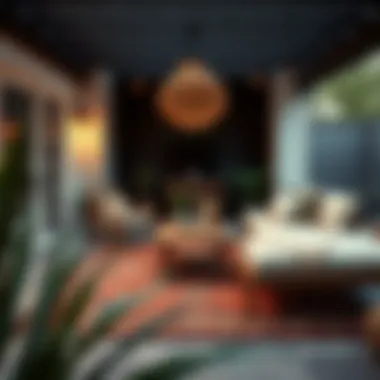
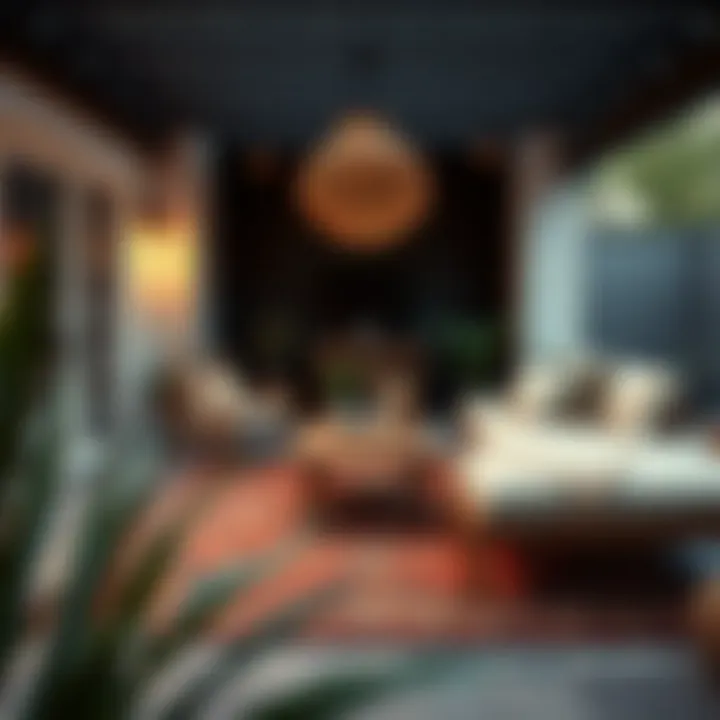
When it comes to color, the trends emerging in rug design are vibrant and diverse. The upcoming seasons will likely see a surge in earthy tones, reflective of a growing desire among consumers to connect with nature. Shades such as terracotta, muted greens, and deep blues could dominate the market, as they evoke warmth and comfort. But there's also a twist; bold jewel tones like emerald and sapphire are making their presence felt, especially in more contemporary settings.
Key Factors to Consider:
- Nature-Inspired Palettes: Colors inspired by natural landscapes resonate with homeowners seeking tranquillity.
- Mix and Match: Layering rugs with various colors can create depth and visual interest in a room.
- Statement Pieces: Rugs with bold patterns in vibrant colors may be used as focal points within minimalist spaces.
Choosing the right hues isn’t just about current trends; it’s about resonating with the atmosphere you wish to create. Whether you are designing a cozy reading nook or a lively social space, raw earthy shades or striking jewel tones can beautifully elevate your surroundings.
Innovative Materials
The shift toward sustainability is also driving innovations in rug materials. More brands are opting for recycled fibers, natural materials like jute and hemp, and even synthetic options designed to limit environmental impact. These advancements speak not only to an ethical ethos but also to durability and versatility in design.
Popular Materials to Watch:
- Recycled PET: From plastic bottles to plush rugs; this material is transformative.
- Bamboo Silk: Offers a luxurious feel with commendable durability while being eco-friendly.
- Natural Wool: Not only sustainable but also hypoallergenic, making it perfect for various indoor environments.
Rugs made from innovative materials will likely gain traction, appealing to eco-conscious consumers. This focus on sustainability paired with unusual textures provides a unique opportunity to make a statement in the often bland world of flooring.
In the world of design, innovation is key to keeping interiors fresh and relevant; by embracing new materials and color palettes, you can craft spaces that are as engaging as they are functional.
As trends emerge and evolve, staying abreast of what's next in rug design becomes invaluable for anyone looking to make their interiors distinct. Understanding these trends will empower you to select pieces that elevate your space, ensuring that your home is not just stylish, but also a reflection of your values and vision.
Rugs and Cultural Significance
Rugs hold a unique place in cultures around the globe, weaving stories both personal and historical into their intricate designs. Beyond their tactile contributions to interiors, they serve as cultural artifacts reflecting the traditions, values, and aesthetics of their regions of origin. Understanding the significance of rugs not only enriches the appreciation of their beauty but also offers insights into cultural identity.
Rugs have been part of human expression for centuries, acting as canvases for artistic representation and storytelling. Each stitch carries meaning; colors and patterns can symbolize everything from local flora to religious beliefs. For instance, the vibrant reds and blues prevalent in Persian rugs are often linked to ancient Persian mythology, breathing life into the narrative of the people who crafted them. Knowing the stories behind these designs can transform how one views and interacts with a rug, turning it from mere decor into a meaningful piece of art.
Symbolism in Traditional Rugs
Traditional rugs are dense with symbols that often carry deep-rooted meanings. In many cultures, for instance, the motifs found in Turkish rugs can represent fertility and abundance. In contrast, the intricate geometric patterns of Moroccan rugs reflect the region’s spiritual beliefs, fostering contemplation and creating a tranquil environment.
- Tile Patterns: Often seen in Persian carpets, alternating colors and tessellated motifs symbolize the cycles of life.
- Animals and Nature Scenes: Rugs depicting animals may evoke characteristics of strength or wisdom, while floral patterns can signify purity or transience.
- Color Meanings: In many traditions, colors convey significance. Red may signify joy, while blue could represent mourning.
Understanding these symbols aids not only in selecting a rug that resonates with personal taste but also fosters a respect for the narratives encapsulated within.
Regional Variations in Design
The diversity of rugs across regions brings to light the varied storylines of human culture and geography. Each region has its signature styles dictated by local materials, weaving methods, and cultural nuances. For example, a Navajo rug is distinct in its use of earthy tones and intricate designs grounded in Native American traditions, often depicting the land and myths of their heritage.
In contrast, a Kilim rug from Turkey is characterized by its flat-weave technique, utilizing bold colors to create striking patterns. These rugs highlight the differences in craftsmanship and aesthetic preferences influenced by environmental factors and historical context.
- Middle Eastern Rugs: Known for detailed artistry, often telling stories through intricate patterns.
- Oriental Rugs: Typically lavish, exuding luxury with their vibrant colors.
- Contemporary Rugs: Reflect modern design, often abstract or minimalist, emphasizing clean lines and subtlety.
As one navigates the world of rugs, recognizing these regional distinctions allows for informed selection and deeper connection to the cultures that produced them. Rugs are not simply floor coverings; they're historical timelines beneath our feet, telling stories that linger in our surroundings.
"The rug is the only item that combines beauty, history, and art with utility, making it a unique expression of human creativity."
Understanding the cultural significance of rugs enriches our perception of home decor, urging one to consider rugs not just for their aesthetic value but also for their deeper narrative meaning. [Sources: en.wikipedia.org, britanica.com]
Closure: The Impact of Rugs in Modern Living Spaces
Rugs play a significant role in shaping modern interiors, offering both aesthetic charm and practical advantages. As versatile elements of design, they can redefine the look and feel of a room, making a thoughtful choice essential for any homeowner or designer. This article outlined how the right rug selection can bring warmth, enhance style, and even improve acoustics.
The value of rugs transcends mere decoration; they often serve as the foundation upon which a room’s ambiance is built. Just as a frame complements a painting, a rug can enhance the visual interest of a space.
Combining Functionality with Aesthetics
In the heart of every well-designed space, there's an equilibrium between functionality and style. Rugs, though often overlooked, can be pivotal in this interplay. For instance, in a bustling family living room, a large, durable rug like a flatweave can be both a soft landing for feet and a vibrant splash of color or texture.
While choosing a rug, consider its placement and functionality. Here are a few insights:
- Color and Pattern: Select hues that tie together the existing elements of the room, while patterns can inject personality and flair.
- Material Considerations: Opt for a fabric that suits the room’s purpose; wool rugs might infuse warmth and comfort, while synthetic fibers can withstand high traffic.
- Layering for Depth: Don’t shy away from experimenting with layered rugs. This technique can create a visually rich narrative, blending work and style seamlessly.
Rugs shouldn’t just sit pretty; they need to make sense within the context of the space, offering purpose as well as beauty. With careful consideration, they can enhance comfort while echoing the aesthetic vision of the entire interior.
Enduring Appeal of Rugs
Despite constant trends in home decor, rugs have maintained their status as a staple in interior design. Their enduring appeal lies in their ability to adapt to different styles, whether it be rustic, modern, or eclectic. As lifestyles evolve, so do the choices in rugs, leading to innovations in materials and patterns that meet contemporary needs.
Rugs can last a lifetime when cared for properly, making them not just an expenditure but an investment. Here are a few reasons to cherish the continuous relevance of rugs:
- Cultural Heritage: Many rugs carry stories from their place of origin, giving them a deeper meaning. Collecting and displaying such pieces can serve as a nod to craftsmanship and tradition.
- Seasonal Adaptability: Rugs can be swapped to signify seasonal changes, allowing rooms to adapt and remain fresh throughout the year. Consider lighter colors for summer and deeper shades for winter to reflect the mood.
- Personal Reflection: A rug can be an expression of personal style, marking a space where one finds solace or gathers with family and friends. This makes the selection process even more meaningful, as it reflects individual taste and lifestyle.
In sum, the impact of rugs in modern living spaces is profound. They effectively meld practicality with style while providing comfort and enhancing acoustic dynamics. Choosing the right rug is not merely an aesthetic decision; it’s a chance to express preferences and insights about lifestyle.
"A well-chosen rug can be the unsung hero of your interior space, framing your style and elevating the ordinary."
As this exploration has shown, the versatile nature of rugs invites creativity and consideration. From functionality to aesthetics, their role in modern interiors is invaluable, making them a significant point of focus in home design.



